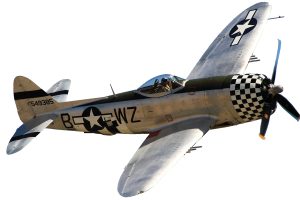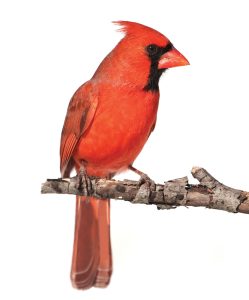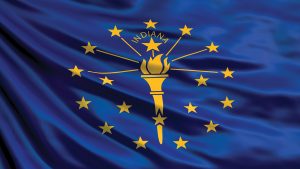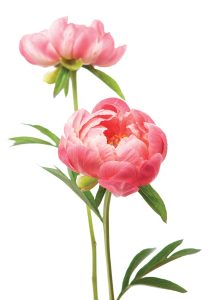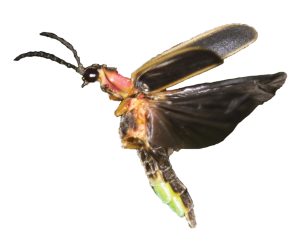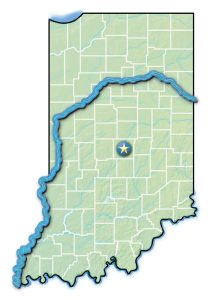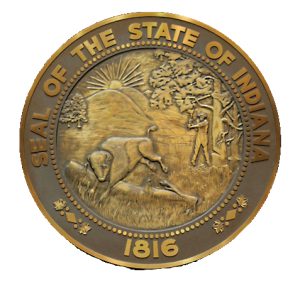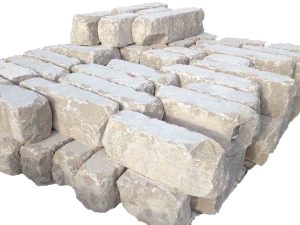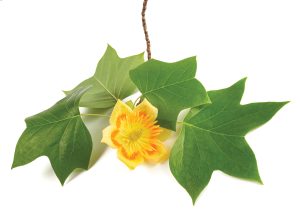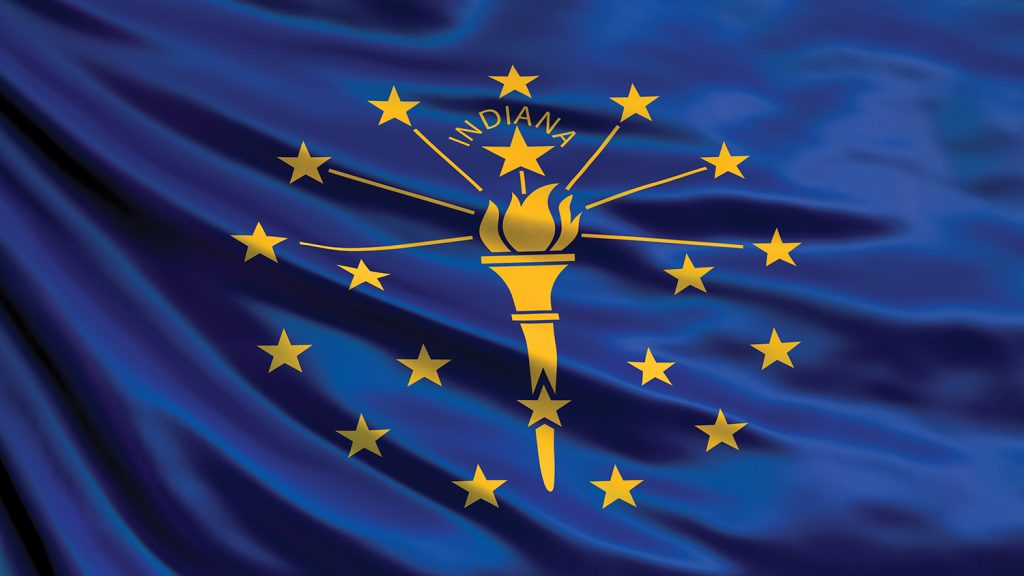
Every true blue-blooded, gold-torch-carrying Hoosier probably knows the official state bird is the native Northern cardinal. And most Hoosiers could likely recite at least part of the refrain of the state song, “On the Banks of the Wabash, Far Away,” whether they live along the Ohio River, the southern tip of Lake Michigan, or in the watershed of the Wabash, the state river itself.
Like every state, Indiana has claimed many flora, fauna, fabricated objects and natural features as officially “ours” through acts of the General Assembly, as noted and amended in the Indiana Code Title 1, Article 2. Though Indiana’s list of official “this” and “thats” is far fewer than other states, such designations raise awareness and foster interest in the given subject. The entire process of naming one can be a learning experience.
When a grade school student from West Lafayette discovered that Indiana had no state insect in 2014, she and her classmates researched insects and then lobbied lawmakers for two years before Say’s Firefly became the official state insect in 2018.
After unveiling his 2023 agenda last month, Gov. Eric Holcomb said a bill would be introduced in this year’s legislature to designate the breaded pork tenderloin as Indiana’s official state sandwich.
Jeanette Merritt with the Indiana Pork Producers Association told Inside INdiana Business the designation will benefit Indiana’s pork producers and the numerous restaurants throughout the state that offer breaded tenderloins.
This month, as the General Assembly continues work on the biennial budget and a variety of other bills, including an official state sandwich, here’s a look at some of Indiana’s official “you-name-its.”
AIRCRAFT
The Republic Aviation P-47 Thunderbolt | Adopted 2015
Known as the “Hoosier Spirit II” and the “Indiana Warbird,” the Republic P-47 Thunderbolt was a World War II-era fighter manufactured at Republic Aviation’s Evansville plant.
This snub-nosed aircraft was built in greater numbers than any other fighter aircraft because it was fast, dependable, could take major damage and survive, and packed effective firepower.
BIRD
Northern Cardinal | Adopted 1933
Commonly known as the “Red Bird,” the Northern Cardinal (Richmondena cardinalis cardinalis) is one of America’s favorite backyard birds. Seven states — Illinois, Indiana, Kentucky, North Carolina, Ohio, Virginia and West Virginia — have made the bird their state bird.
Widespread and abundant, cardinals stick around year-round to brighten our gray Indiana winters. They are recognized by their “cheer cheer cheer,” “whit-chew whit-chew” and “purty purty purty” whistles. Of course, if you follow the Ball State University Cardinals, the “cheer” is more like a “Chirp! Chirp!”
FLAG
Adopted 1917
The blue and gold state flag of Indiana was adopted by the 1917 General Assembly as part of the 1916 Indiana centennial celebration. At the time, Indiana was the last state to have an official flag.
The Daughters of the American Revolution held a competition to design the flag, which was won by Paul Hadley of Mooresville.
The flag features a golden torch and 19 stars on a blue field. The torch is a symbol of liberty and enlightenment; the rays represent their far-reaching influence. Thirteen stars in the outer circle symbolize the original 13 states; the inner semi-circle of five stars represents the next five states to join the Union; and the large star above the torch is a symbol of Indiana, the 19th state.
FLOWER
Peony | Adopted 1957
Though extensively grown as an ornamental plant for its very large and scented blooms, the peony (Paeonia) is not without controversy.
The peony is native to China, not Indiana. So, how did it get to be the state flower? According to a 2017 article in the Indianapolis Star, it was all politics.
Indiana has had four official state flowers. The carnation (native to England) was adopted by the legislature in 1913. The second, the flower of the tulip tree (actually native to Indiana), was adopted in 1923. Third, the zinnia (from Mexico) was adopted in 1931, the year the tulip tree itself became the state tree.
In 1957, a bill in the Senate called for the tulip tree blossom to be reinstated. It was then changed to the dogwood blossom. By the time it got to the House, a representative who was a commercial peony grower pushed for an amendment to make it the peony — which passed.
In 1995, a grassroots effort to select an Indiana native plant as the new state flower settled on the fire pink, which has tiny clusters of red starlike wildflowers, but that effort wilted in the legislature.
FOSSIL
Mastodon | Adopted 2022
Unlike the state flower, the state fossil walked its way across Indiana as far back as 2.5 million years ago. American mastodons (Mammut americanum) roamed Indiana until they became extinct about 10,500 years ago. Mastodons are now the most common Ice Age fossil found in the state.
Mastodons lived in herds and were predominantly forest-dwelling animals, as opposed to their contemporary, the larger, shaggier woolly mammoth, which mostly lived on grasslands.
The Indiana State Museum’s 2018 redesign allowed it to fully display Fred, the fossilized bones of a mastodon that was discovered in a peat bog near Fort Wayne in 1998.
INSECT
Say’s Firefly | Adopted 2018
The successful quest to name a state insect began with Kayla Xu, a West Lafayette second grader who realized Indiana was without a state insect during the 2014-15 school year.
Encouraged by her teacher, Maggie Samudio, Kayla and her classmates at Cumberland Elementary researched possible insects. In their research, they learned Purdue University entomologists had suggested Say’s Firefly 20 years earlier. Say’s Firefly, Pyractomena angulata, was a species first described in the 1820s by Thomas Say, the “Father of American Entomology” in New Harmony. The students picked up the torch for the firefly and carried it to the Statehouse.
Lawmakers from the West Lafayette area first joined with the students to author bills in 2017. Then, in 2018, Holcomb backed their proposal, and it passed that session.
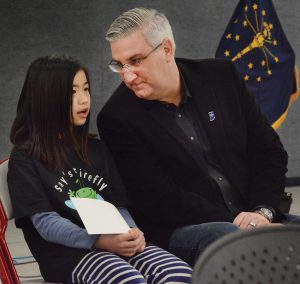
“I know this bill bugged some of my legislative friends,” Holcomb said afterward, “but the truth is it’s a big deal to young students around the state who have reached out to us in support … Beyond the satisfaction these kids will feel when they look out on a hot Indiana summer night and see the state insect flashing away, the real beauty of this bill is the civic engagement it inspired in our youngest citizens. It’s taught them a great deal about how our lawmaking process works — and that if they are engaged, they can make a real difference.”
Before students and guests at Cumberland Elementary’s gym, Holcomb had Kayla rest her hand on his as he signed the firefly bill into law. (Links to two previous stories about the students and the firefly can be found in this story on our website.)
POEM
“Indiana” by Arthur Franklin Mapes | Adopted 1963
The poem, by Kendallville’s Arthur Franklin Mapes, was written in 1961. In part, it reads:
God crowned her hills with beauty,
Gave her lakes and winding streams,
Then He edged them all with
oodlands
As the settings for our dreams.…
Indiana … is a garden
Where the seeds of peace
ave grown,
Where each tree, and vine,
nd flower
Has a beauty … all its own.
Lovely are the fields and meadows,
That reach out to hills that rise
Where the dreamy Wabash River
Wanders on … through paradise.
RIFLE
Grouseland Rifle | Adopted 2012
The “Grouseland Rifle” is a long rifle created in the early 1800s for the then-governor of the Indiana Territory, William Henry Harrison. The firearm is kept in Vincennes at its namesake Grouseland, Harrison’s previous home as territorial governor.
The rifle was crafted by Col. John Small of Vincennes. The Grouseland mansion is now a museum maintained by The Grouseland Foundation at 3 W. Scott St. in Vincennes. Visitors can not only see the Indiana state rifle, but also an interpretation of territorial life and why the gun was important, and learn more about the legacy of William Henry Harrison, the westward expansion of the country and the development of the state of Indiana.
RIVER
Wabash River | Adopted 1996
The Wabash is the longest river in Indiana, flowing some 500 miles through or along 18 counties and through 11 county seats.
From its origin in western Ohio, the Wabash enters Indiana as a trickle near New Corydon in northern Jay County. It then flows westerly across Northern Indiana until it takes a sharp lefthand turn southward to eventually form the state’s southwestern border with Illinois before flowing into the Ohio River.
Along the southwest corner of the state, the Wabash played a crucial role in the founding of Vincennes, Indiana’s first city, from where so much of Indiana’s history flows.
The Wabash River is also the theme of Indiana’s state song, is mentioned in the state poem, is part of the name of Indiana’s honorary award (the Sagamore of the Wabash), and runs beside Grouseland (home of the state rifle) and New Harmony, where Say discovered the state firefly.
SEAL
Adopted 1816
Versions of this pioneer scene are found on official Indiana documents as early as 1801, when it was the Indiana Territory.
A state seal was provided for in the 1816 and 1851 Indiana constitutions, but it was not until 1963 that the Indiana General Assembly provided an official description for the state seal.
The Indiana seal design consists of a woodsman chopping a tree with his ax and a buffalo jumping over a log, with sycamore trees, hills in the background and a sun with 14 rays.
SNACK
Indiana-Grown Popcorn | Adopted 2021
According to the USDA, Indiana was the nation’s largest popcorn producer in 2021. Nearly 100,000 acres were devoted to growing popcorn, particularly in White and Pulaski counties. Orville Redenbacher’s, Pop Weaver and Cousin Willie’s are all popular popcorn brands that originated in Indiana.
SONG
“On the Banks of the Wabash, Far Away” | Adopted 1913
The song was composed by Paul Dresser, reminiscing about his childhood home along the Wabash River in Terre Haute. Dresser wrote the song in 1897. Its bittersweet chorus begins, “Oh, the moonlight’s fair tonight along the Wabash.”
It was among the best-selling songs of the 19th century, earning over $100,000 from sheet music revenues, and it remained popular for decades. It was among the earliest pieces of popular music to be recorded.
Dresser’s birthplace and boyhood home, a state shrine listed on the National Register of Historic Places, now sits in Terre Haute’s Fairbanks Park, a stone’s throw from the river. Dresser was actually born “Dreiser” and was the older brother of novelist and social reformer Theodore Dreiser.
STONE
Limestone | Adopted 1971
The Indiana variety of limestone, also called Salem or Bedford, is significantly quarried in south-central Indiana. It is a high-quality stone that has been used in buildings such as the Empire State Building and the Pentagon.
Bedford is known as the “Limestone Capital of the World.” Limestone quarried and carved in Bedford is featured on famous buildings across America. Indiana’s Statehouse in Indianapolis was also built with southern Indiana limestone.
According to the Minerals Education Coalition: “Limestone is a sedimentary rock composed mostly of the mineral calcite and comprising about 15% of the Earth’s sedimentary crust. It is a basic building block of the construction industry and a chief material from which aggregate, cement, lime and building stone are made.”
TREE
Tulip Tree | Adopted 1931
The tulip tree (Liriodendron tulipifera), also called the tulip poplar or yellow poplar, has a distinctive leaf shape and huge, bell-shaped flowers that appear in May or June. It is a tall tree that grows throughout Indiana. Incidentally, its flower was the state flower (as noted previously) from 1923-1931. The tree’s soft white wood has many uses.
Though referred to as a poplar, it’s actually a member of the magnolia family.
Sources for this story include:
https://statesymbolsusa.org/states/united-states/indiana
https://iga.in.gov/legislative/laws/2016/ic/titles/001/
https://www.in.gov/history/about-indiana-history-and-trivia/emblems-and-symbols/

